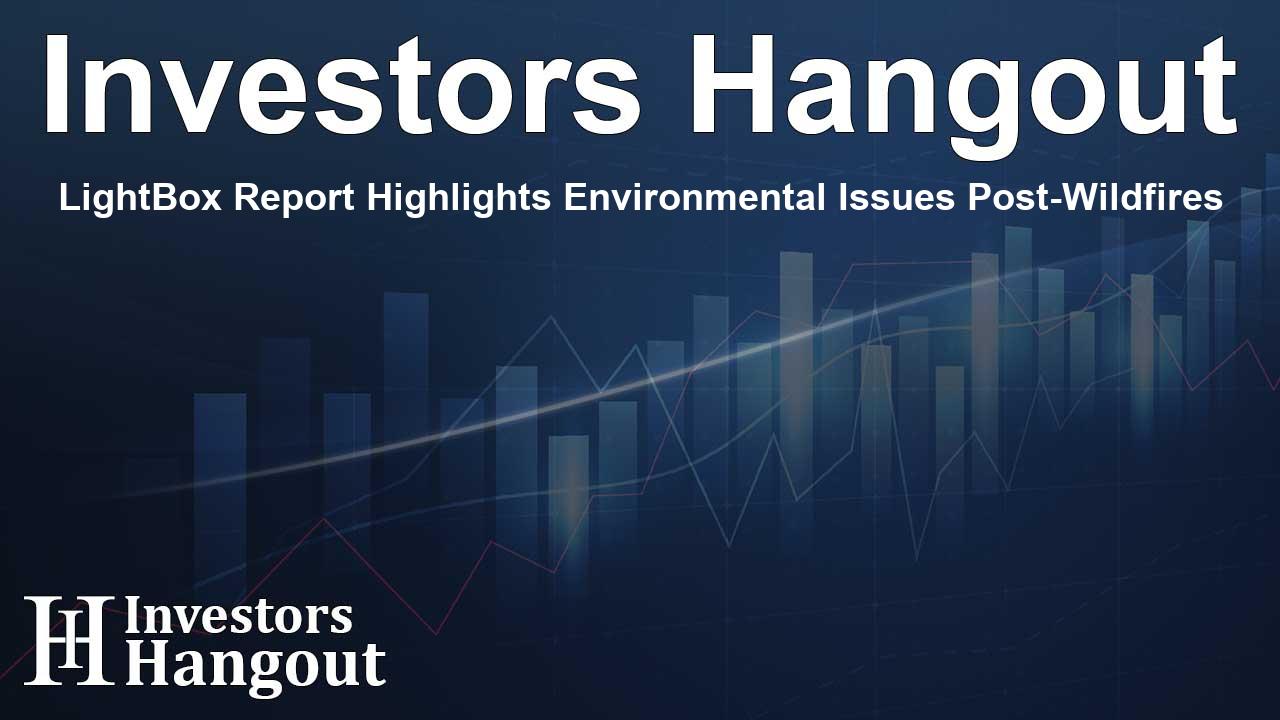LightBox Report Highlights Environmental Issues Post-Wildfires

LightBox Report Highlights Environmental Issues Post-Wildfires
LightBox Opens Access to Wildfire Response Map to Assist Recovery Efforts
The latest report from LightBox sheds light on significant environmental hazards in areas affected by the recent wildfires in Southern California. The company offers valuable resources to support communities in rebuilding safely.
Understanding the Environmental Risks
The LightBox report underscores alarming environmental issues identified in the Palisades and Eaton fire areas. Notable findings indicate that in the Palisades zone alone, over 10,000 structures have been damaged, including around 200 businesses. Additionally, around 700 properties have been flagged as likely contaminated due to hazardous materials, with 150 having underground storage tanks.
Details on Impacted Areas
In the Eaton fire zone, the LightBox analysts observed more than 9,000 impacted structures, including 175 businesses. Approximately 600 of these properties were noted for potential hazardous material contamination, alongside 75 underground storage tanks. These alarming statistics highlight the necessity for immediate action in terms of environmental safety during recovery.
Gap of Traditional Risk Models
The report, led by Richard W. White, Director of Research and Development for LightBox, points out a critical flaw in traditional risk assessment models. These models often overlook emerging hazards following wildfires, relying on outdated land use and property records. This oversight can lead to significant health risks during cleanup efforts.
For instance, recent data from CA HAZNET revealed over 40 entries related to asbestos waste in a single neighborhood affected by wildfires, emphasizing the urgent need for updated environmental assessments.
Voices of Experts
Caroline Stoll, General Manager of Data and Analytics at LightBox, comments on the implications of this data, stating, "This data changes everything. If property records indicate no asbestos risk but hazardous waste tracking tells a different story, it can completely alter the cleanup and rebuilding plans and dramatically minimize human health exposure." This statement serves to stress the importance of accurate data in protecting community well-being during recovery.
Encouraging a Data-Driven Approach
LightBox advocates for a more comprehensive data-driven approach to address hidden environmental threats in rebuilding efforts. To support this initiative, the company offers free access to its Wildfire Response Map, which serves as a vital tool for environmental engineers, public agencies, and community members.
This resource provides real-time environmental risk mapping aimed at preventing costly rebuilding mistakes that may threaten lives and generate significant financial losses in the future.
Importance of Real-Time Data
LightBox Data Scientist Zach Wade emphasizes the importance of real-time environmental risk mapping, indicating that, "With the goal to rebuild safer, not just faster, communities need to stop relying on incomplete data." This proactive approach helps negate the chances of dangerous rebuilding errors that could have life-altering consequences.
About LightBox
LightBox stands at the forefront of delivering innovative geospatial intelligence and property data solutions. Committed to advancing customer objectives, LightBox equips over 30,000 clients across commercial and governmental sectors with essential tools to navigate complex decisions and minimize risk in real estate operations.
The diverse client base includes brokers, developers, investors, lenders, insurers, technologists, and environmental consultants, showcasing LightBox's extensive reach. Their mission emphasizes excellence and fostering connections within the industry, aiming to illuminate the path to informed real estate solutions.
Frequently Asked Questions
What does the LightBox report reveal about wildfire recovery?
The LightBox report uncovers significant environmental concerns, highlighting thousands of impacted structures and potential contamination risks.
Who authored the LightBox report?
The report was authored by Richard W. White, the Director of Research and Development at LightBox.
Why are traditional risk models inadequate?
Traditional risk models often rely on historical data and fail to capture emerging hazards like those seen after wildfires.
What resource does LightBox provide for recovery efforts?
LightBox offers a Wildfire Response Map at no cost to help prevent rebuilding mistakes and ensure safer reconstruction.
How does real-time data impact recovery planning?
Real-time data is critical for accurate assessments and helps communities avoid dangerous rebuilding errors that could risk lives and resources.
About The Author
Contact Addison Perry privately here. Or send an email with ATTN: Addison Perry as the subject to contact@investorshangout.com.
About Investors Hangout
Investors Hangout is a leading online stock forum for financial discussion and learning, offering a wide range of free tools and resources. It draws in traders of all levels, who exchange market knowledge, investigate trading tactics, and keep an eye on industry developments in real time. Featuring financial articles, stock message boards, quotes, charts, company profiles, and live news updates. Through cooperative learning and a wealth of informational resources, it helps users from novices creating their first portfolios to experts honing their techniques. Join Investors Hangout today: https://investorshangout.com/
The content of this article is based on factual, publicly available information and does not represent legal, financial, or investment advice. Investors Hangout does not offer financial advice, and the author is not a licensed financial advisor. Consult a qualified advisor before making any financial or investment decisions based on this article. This article should not be considered advice to purchase, sell, or hold any securities or other investments. If any of the material provided here is inaccurate, please contact us for corrections.
